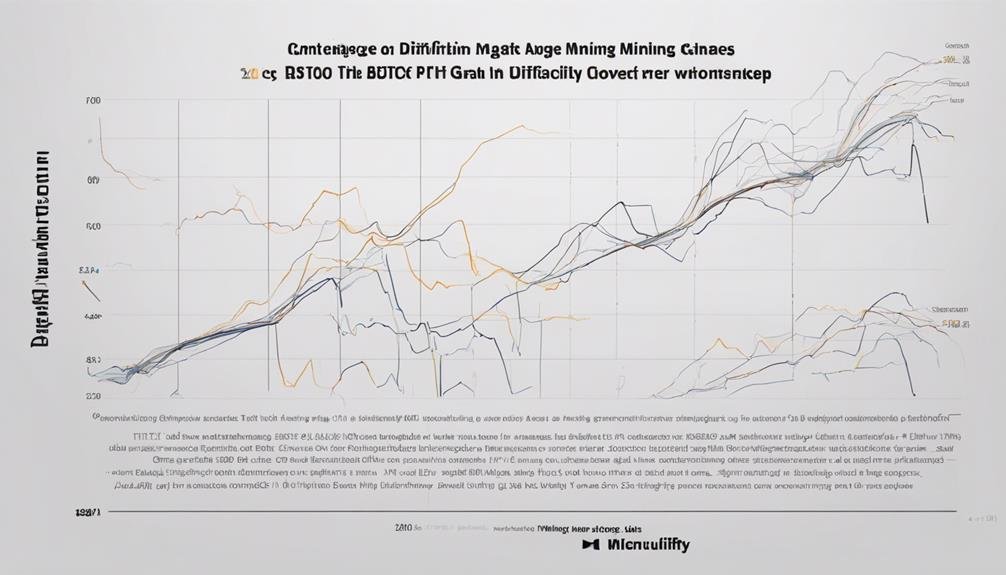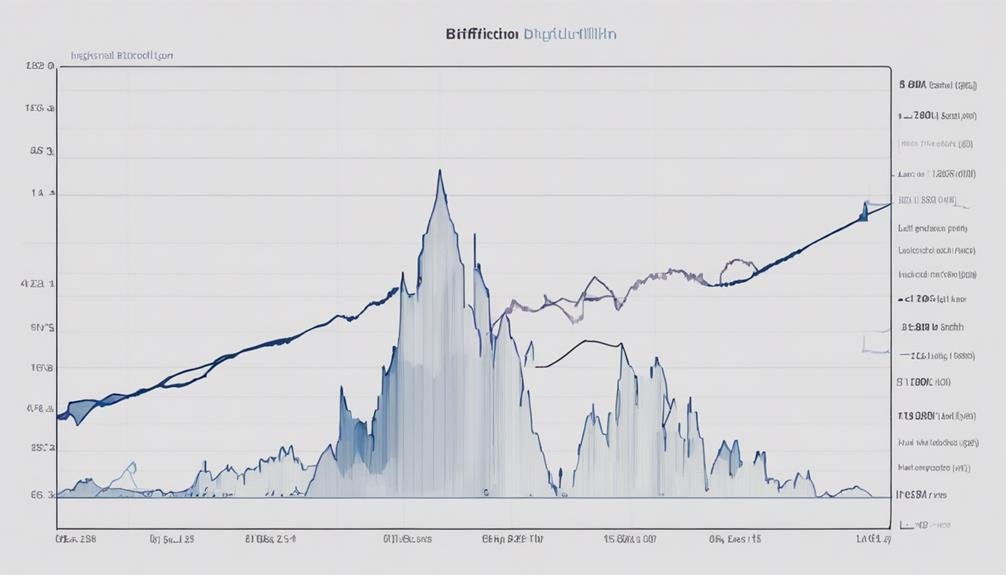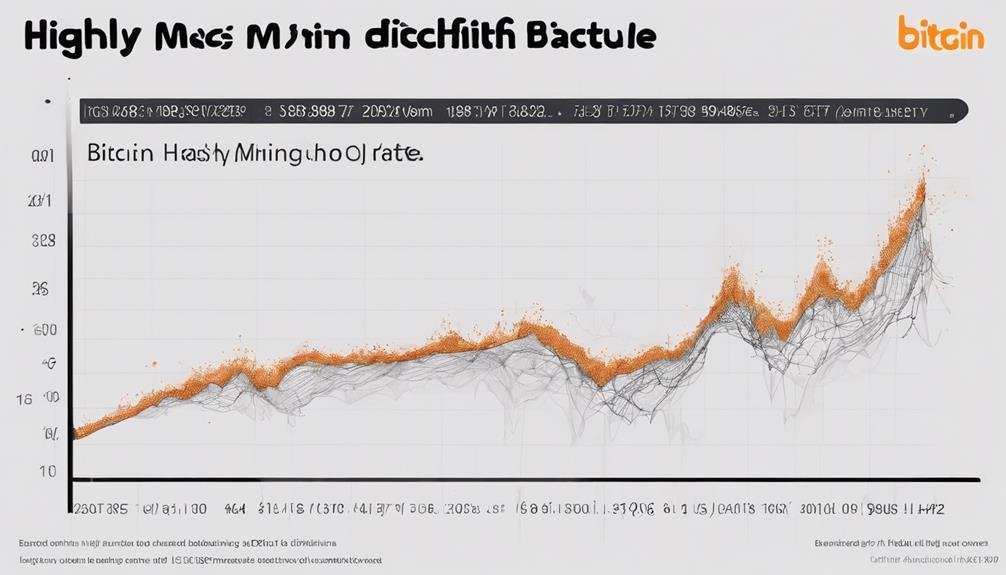As you navigate the intricate web of Bitcoin mining difficulty, it’s like unraveling a complex puzzle that holds the key to revealing the future of digital currency. The interplay between mining difficulty adjustments, the impact of halving events, and the strategies miners employ to stay ahead in this competitive landscape are all vital elements to grasp.
Explore these 10 best insights to gain a deeper understanding of the challenges and opportunities within the domain of Bitcoin mining difficulty and uncover the secrets that shape the very foundation of this evolving industry.
Table of Contents
Key Takeaways
- Bitcoin mining difficulty adjusts every 2016 block for a consistent block time.
- Difficulty exceeding 80 trillion poses challenges for miners’ profitability.
- Factors like technology, market dynamics, and energy costs influence mining difficulty.
- Adapting to competitive challenges and managing complex changes are crucial for miners’ success.
Understanding Bitcoin Mining Difficulty

To comprehend Bitcoin mining’s difficulty effectively, you must grasp its intricate relationship with network dynamics and technological advancements. Bitcoin mining difficulty refers to how hard it is to find a new block compared to the easiest it can ever be. This difficulty is adjusted approximately every 2016 block to ensure the average block time remains 10 minutes.
As more miners join the network, the difficulty increases in maintaining this block time, reflecting the growing competition in the mining space.
The current difficulty of Bitcoin mining exceeding 80 trillion showcases the intense competition among miners vying to validate transactions and secure new blocks. The current Bitcoin hashrate is 526.97 EH/s, representing the global Bitcoin network hashrate with a mining difficulty of 83.95 T at block height 834,832.
This difficulty directly impacts miner rewards, with the current block reward at 6.25 bitcoins. Understanding Bitcoin mining difficulty is essential as it influences mining profitability, competitiveness, and resource allocation within the network. Technological advancements, network participation levels, and market dynamics significantly shape Bitcoin mining difficulty and its associated block times.
Impact of Difficulty Adjustments

The impact of difficulty adjustments in Bitcoin mining is a critical factor influencing miner profitability and operational efficiency.
Key Points
- Consistent Block Time: Difficulty adjustments occur every 2016 block to maintain a steady 10-minute block time in Bitcoin mining, ensuring the network’s stability and predictability.
- Profitability Challenges: With the current mining difficulty exceeding 80 trillion, miners face reduced profitability, especially those utilizing older, less efficient machines like the Bitmain S9. This poses challenges to their operational efficiency and overall success.
- Business Planning: Difficulty adjustments are pivotal in miners’ business planning, directly impacting hash price and potential rewards. Understanding these adjustments is vital for miners to strategically navigate the dynamic landscape of Bitcoin mining and optimize their operations for sustained profitability.
Factors Influencing Mining Difficulty

Factors influencing Bitcoin mining difficulty encompass various variables, including technological advancements, network participation levels, market dynamics, energy costs, and cryptocurrency price fluctuations.
Bitcoin miners constantly aim to enhance their mining operations by investing in more advanced hardware, which can impact the overall mining difficulty. Changes in the number of miners participating in the network can lead to adjustments in difficulty levels to maintain the average block time. Market dynamics, such as shifts in Bitcoin price and demand, play an essential role in determining the mining difficulty, as they affect the profitability of mining operations.
Additionally, energy costs impact the expenses associated with mining, thereby influencing the overall difficulty for miners. Cryptocurrency price fluctuations can directly impact mining difficulty through the adjustment mechanism, ensuring that blocks are mined consistently. Understanding these factors is essential for Bitcoin miners to navigate the challenges of difficulty adjustments and optimize their mining strategies.
Historical Trends in Difficulty

As you analyze the historical trends in Bitcoin mining difficulty, you’ll notice the intricate interplay between the difficulty adjustment mechanism and the impact of halving events. These trends provide valuable insights into how the network has evolved and adapted, showcasing the resilience and innovation within the mining ecosystem.
Understanding how these factors have influenced difficulty levels can offer essential perspectives on the challenges and opportunities that miners face in the dynamic landscape of cryptocurrency mining.
Difficulty Adjustment Mechanism
With each modification of every 2016 block, Bitcoin mining difficulty undergoes a steady evolution, reflecting the network’s growth and ensuring its security and stability.
Key Points
- Consistent Adjustment: The 2016 block cycle allows the difficulty to be recalibrated, maintaining the average block time of 10 minutes.
- Historical Increase: Over time, the difficulty of mining has shown a consistent upward trend, exceeding 80 trillion.
- Critical for Security and Stability: These modifications are crucial for the network’s robustness, preventing issues like rapid block generation or prolonged block times.
Understanding the intricacies of the difficulty adjustment mechanism provides valuable insights into the ongoing development and maintenance of the Bitcoin mining ecosystem.
Impact of Halvings
The impact of Bitcoin halvings on mining difficulty is a pivotal aspect to contemplate when analyzing historical trends in the network’s security and stability evolution. Bitcoin halvings, occurring approximately every four years, lead to a reduction in block rewards, directly impacting miner profitability.
These events trigger adjustments in mining difficulty to uphold network stability and maintain consistent block times. Historically, there is a surge in mining activity before halvings as miners seek to maximize rewards before the reduction.
However, many less efficient miners may cease operations post-halving due to decreased profitability. Understanding the impact of halvings on mining difficulty underscores the necessity for miners to adapt strategically to these periodic shifts in the Bitcoin ecosystem.
Significance of Difficulty Levels

Traversing the intricate landscape of Bitcoin mining involves acknowledging the profound impact that difficulty levels wield on operational efficiency and profitability. Understanding the significance of difficulty levels is paramount for miners who navigate this competitive arena effectively. Here are three key points to contemplate:
- Maintaining Block Time: Bitcoin mining difficulty levels play a critical role in maintaining a consistent block time of approximately 10 minutes. This consistency guarantees the smooth functioning of the network and the timely validation of transactions.
- Network Stability and Security: Difficulty adjustments occur every 2016 block to uphold the network’s stability and security. These adjustments are essential for adapting to changes in mining power and maintaining the integrity of the Bitcoin blockchain.
- Miner Rewards Impact: Difficulty directly influences miner rewards, with the current block reward set at 6.25 bitcoins per block. As the difficulty level increases, miners face higher competition, making it essential for them to optimize their operations to remain profitable in this challenging environment.
Challenges Faced by Miners

Exploring the domain of Bitcoin mining presents miners with many challenges, particularly in the face of rising mining difficulty levels that directly impact profitability and operational efficiency.
As mining difficulty escalates, miners encounter intensified competition, making it harder to secure block rewards. This heightened competition necessitates a continuous upgrade of mining equipment to maintain competitiveness.
Miners often need help balancing the escalating electricity costs required to power their mining rigs with diminishing returns due to increased difficulty.
Additionally, the periodic difficulty adjustments every 2016 block present planning challenges for miners, requiring them to adapt their strategies promptly. This adjustment mechanism keeps the average block production time around 10 minutes.
For miners utilizing older equipment, the increasing difficulty levels pose a significant hurdle to operational efficiency and overall profitability. To navigate these challenges successfully, miners must stay abreast of technological advancements and continually reassess their operational strategies to make sustainable mining practices amidst the evolving landscape of Bitcoin mining difficulty.
Future Projections for Difficulty

What factors contribute to the projected increase in Bitcoin mining difficulty over the coming months?
- Growing Hash Rate: The network hash rate record levels suggest increasing mining activity. A higher hash rate indicates more miners participating in securing the network, leading to more competition and, consequently, a rise in mining difficulty.
- Market Dynamics: Factors like the price of Bitcoin, transaction fees, and the production of ASIC miners play vital roles in determining the equilibrium hash rate. Long-term forecasting models consider these variables to estimate future difficulty adjustments accurately.
- Innovative Adjustment Methods: Luxor’s rolling-block approach stands out for its precision in difficulty adjustments. Utilizing data from previous blocks and considering the previous epoch’s adjustments enhances the accuracy of predicting future difficulty levels, aiding miners in planning for the evolving landscape of Bitcoin mining.
As the hash rate continues to surge and market dynamics evolve, the projected increase in Bitcoin mining difficulty remains critical for miners to navigate successfully.
Relationship Between Hash Rate and Difficulty

The direct correlation between the hash rate and mining difficulty in the Bitcoin network underscores the interdependence of these critical metrics in shaping the operational landscape for miners. As the hash rate increases, the mining difficulty follows suit to ensure that blocks are mined consistently.
This adjustment occurs approximately every 2016 block, reflecting the dynamic nature of the network. When the mining difficulty hits a certain threshold, miners may find it more challenging to solve the cryptographic puzzles required to validate transactions and secure the Bitcoin blockchain.
A high hash rate signifies a robust and secure network. Still, miners also need more computational power to compete effectively. Consequently, miners must continuously adapt their strategies to account for fluctuations in both hash rate and difficulty.
Understanding this relationship is vital for anticipating changes in competition and resource requirements necessary to mine Bitcoin blocks successfully.
Strategies for Managing Difficulty Changes

To effectively navigate fluctuations in Bitcoin mining difficulty, miners must employ strategic approaches to optimize their operations and maintain profitability. Managing complex changes in the Bitcoin network is essential for sustaining efficient mining operations. Here are three key strategies to take into account:
- Hardware Upgrades: Constantly upgrading your mining hardware can increase efficiency and hashing power, helping you stay competitive in the network despite complex adjustments.
- Joining Mining Pools: Joining mining pools can enhance your chances of earning rewards by combining computational resources with other miners. This collaborative effort can mitigate the impact of difficulty changes on individual miners.
- Cost-Benefit Analysis: Balancing electricity consumption costs with mining rewards is essential during fluctuations in difficulty. Regularly evaluating your operational expenses against potential rewards can help you make informed decisions to optimize profitability in varying market conditions.
Implications of Halving Events

As Bitcoin’s halving event approaches, it is essential to analyze its potential impact on mining operations and the broader market. Predicting how miners will react to the reduced block rewards and the subsequent network hash rate adjustments is critical.
Understanding these implications can provide valuable insights into the future stability and dynamics of the Bitcoin ecosystem.
Halving Impact Analysis
With the upcoming halving event looming, a significant shift in mining dynamics is anticipated as block rewards halve from 6.25 to 3.125 bitcoins in April. This reduction in mining rewards can have the following implications:
- Increased Competition: Miners may intensify their efforts to secure as many bitcoins as possible before the halving occurs.
- Potential Miner Exodus: Research suggests that up to 20% of miners could go offline post-halving due to reduced rewards, impacting the network’s hash rate.
- Risk for Less Efficient Miners: The halving event may disproportionately affect less efficient miners, potentially consolidating mining power among more efficient participants.
Market Reaction Predictions
Anticipate a shift in market dynamics as the Bitcoin halving event approaches, signaling potential implications for mining operations and market reactions. Miners are gearing up for increased mining activity leading up to the halving to capitalize on accumulating more Bitcoins.
However, post-halving, Galaxy Digital research suggests that around 20% of miners may go offline, leaving only the most efficient operations running. This departure could result in approximately 15-20% of the network hash rate going offline, impacting mining operations considerably.
Older mining machines, such as the Bitmain S9, might have to be shut down due to the heightened difficulty and reduced rewards following the halving. The impending halving event, reducing block rewards by half from 6.25 to 3.125 coins, is a pivotal factor fueling current mining trends and market reactions.
Frequently Asked Questions
What Increases Bitcoin Mining Difficulty?
When more miners join the network and boost computational power, Bitcoin mining difficulty increases. Factors like hardware improvements and market dynamics also play a role. Higher energy costs and increased network participation contribute to the rising difficulty levels.
How Hard Is It to Get Into Bitcoin Mining?
Are you into Bitcoin mining? It’s like diving into a digital gold rush. Entry barriers include costly ASIC miners, electricity bills, and fierce competition. Profitability hinges on factors like hardware efficiency and Bitcoin’s price fluctuations.
Getting into Bitcoin mining can be challenging due to various factors such as the high upfront costs, technical knowledge required, and the increasing competition in the mining industry. Here are some key points to consider:
- Technical Knowledge: Understanding how Bitcoin mining works, the hardware required, and how to set up and maintain mining equipment is essential. It involves a fair amount of technical expertise.
- Costs: Mining equipment can be expensive, and the costs of electricity and cooling to run the equipment can also add up. Additionally, there may be ongoing maintenance costs to keep the equipment running efficiently.
- Competition: The Bitcoin network has a high level of competition, with many miners vying to solve complex mathematical problems to validate transactions and earn rewards. As more miners join the network, the difficulty of mining increases, making it harder to mine Bitcoin profitably.
- Risk: The volatile nature of Bitcoin prices can also impact the profitability of mining. Fluctuations in the price of Bitcoin can affect the rewards miners receive for their efforts.
While getting into Bitcoin mining can be challenging, it is not impossible. It requires careful consideration of costs, technical knowledge, and the ability to adapt to the changing landscape of the mining industry. It is essential to do thorough research and consider all factors before investing in Bitcoin mining.
What Is the Difficulty Index for Bitcoin Mining?
To grasp the difficulty index for Bitcoin mining, explore the algorithm’s nuances. Understanding it enhances mining efficiency. The index adjusts every 2016 blocks, aligning with the 10-minute block time target. Dive deep for clarity. Bitcoin Average Difficulty is at a current level of 82.71, up from 79.35 yesterday and up from 43.55 one year ago. This is a change of 4.23% from yesterday and 89.91% from one year ago.
How to Solve Bitcoin Mining Problems?
To solve Bitcoin mining problems efficiently:
- Focus on mining optimization strategies.
- Upgrade hardware to meet current requirements and maximize computational power.
- Join mining pools for increased chances of earning rewards.
- Stay updated on algorithm changes for competitive advantage.
Conclusion
You’ve navigated the complex world of Bitcoin mining difficulty with precision and foresight. As you gaze into the future, remember that the landscape is ever-changing, like a shifting tide on the vast ocean of cryptocurrencies.
Stay vigilant, adapt to the challenges, and ride the waves of innovation to secure your place in the competitive mining world. The journey may be tumultuous, but the rewards are worth the effort.



